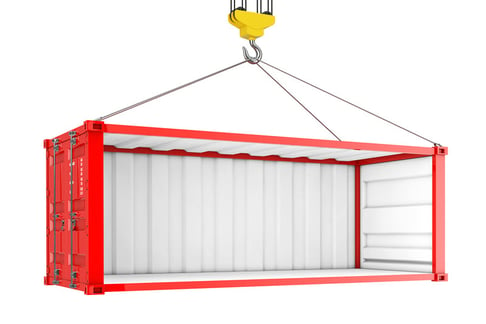Ocean container shipping has become very expensive – in some cases triple what it was pre-pandemic. So, you don’t want to ship more containers than needed for your volume of freight. That requires smart ocean container loading.
For the purpose of this article, we’ll focus on loading of 20’ and 40’ containers. For a full list of container types and sizes, check out “container specifications” on our Resource Page.
Loading Standard Pallets
 If you’re shipping from the US to Europe, you’re using the standard 48” by 40” pallet. For these, the calculation for how many pallets can fit in a container is simple: 10 pallets on the floor for a 20’ container and 20 pallets on the floor for a 40’ container. The question then is whether your type of product can be stacked and if the height of the cargo allows this. If the answer is yes, then you can fit 20 standard pallets into a 20’ container and 40 pallets in a 40’ container, assuming you don’t run up against weight limits.
If you’re shipping from the US to Europe, you’re using the standard 48” by 40” pallet. For these, the calculation for how many pallets can fit in a container is simple: 10 pallets on the floor for a 20’ container and 20 pallets on the floor for a 40’ container. The question then is whether your type of product can be stacked and if the height of the cargo allows this. If the answer is yes, then you can fit 20 standard pallets into a 20’ container and 40 pallets in a 40’ container, assuming you don’t run up against weight limits.
If you’re using a standard European pallet (47.24” by 39.37”) they are just a bit longer and narrower than the standard US pallet, but the formula described above really doesn’t change.
Ship Heavy and Save
So we dealt with the space aspects of ocean container loading, now how about weight? The key thing to remember here is that the container weight that keeps you within legal limits on US roads is NOT the same as the maximum weight you can put in a container. Using a standard tractor/trailer, carriers can easily handle a 44,000-lb container and still stay below the DOT’s 80,000 lb weight limit. But you can load about 10,000 lbs more weight on your container and still be within the maximum gross cargo weight listed on the container door. Check out our guide on “How to Reduce Costs in Heavy Freight Shipping.”
If you ship very dense freight (e.g., water bottles, metal, knock-down furniture), where you weigh out before you cube out, here are 2 profit enhancing options to consider.
- Maximize the weight on the container to ship (and pay for) few containers. The container cost is the same regardless of weight. Then contract with a local trucker (or have your forwarder do it) that has the permits to haul overweight loads. You’ll ship 20–25% fewer containers and cut your ocean shipping costs by the same percentage. Your specialized landside trucking will add to the cost, but that added cost is more than offset by the ocean savings, with net savings easily reaching the 6-figure mark annually for many shippers.
- Follow the same strategy as above but, instead of contracting a heavyweight trucker, have your forwarder arrange for your goods to be transloaded onto standard dry van trucks for final delivery. So your 4-container shipment might require 5 trucks for final delivery to stay within DOT weight limits. You won’t save as much as option #1, but there is still measurable savings to be had. And, frankly, many truckers these days are not handling heavy loads since they don’t want the added fuel cost and vehicle wear and tear. Given the high demand these days to haul standard size/weight containers, truckers can stay busy hauling “easy” freight.
Odd-sized Freight
If your challenge in ocean container loading involves odd-sized, out-of-gauge freight that does not fit a standard loading formula, as they say “there’s an app for that.” Stowage planning software can plug in all the various size boxes and pieces you have and kick out multiple stowage options for the container. I.C.E. Transport uses such software regularly to ensure you make the most efficient use of container space.
Ocean Container Loading
You may not be able to reduce what steamship lines charge you to ship a container, but through smart ocean container loading, you can maximize the volume of goods in each container and reduce total annual container count to save money. To learn more, contact I.C.E. Transport to arrange a discussion.




